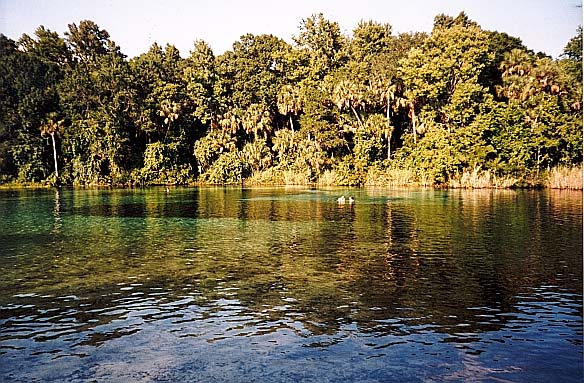Alexander
Springs, Florida
![]()
1999
 Me and a couple of my
kayaking friends take a trip down to the Ocala National Forest for a summer
paddle in 1999. Our first destination is Salt Springs, but we abandon that idea
when we have a look at the river and notice that at mid-point, it seems rather
wide and open. Our fallback river is Alexander, since my friends had not
paddled the river yet. I warn them that the river is not one of my favorites,
since I remember it being fairly wide. Sure enough, the crystal clear water is
wide and slow for the first hour or so of paddling. But then we come upon river
that I don't remember. It turns out that when I canoed it in 1988, I rented a
canoe from the park for 2 hours, and turned back after an hour. As a result,
approximately half of my kayak trip this second time is a new and,
surprisingly, a delightful experience. The photo above, showing us kayaking the
river, is a sample of what we see on our paddle. Alexander is a very unusual
river in the sense that it starts out slow-moving and wide, but downstream
becomes quite narrow, swift, and intimate. This downriver portion is so
exceptional that I vow to return again for a third trip.
Me and a couple of my
kayaking friends take a trip down to the Ocala National Forest for a summer
paddle in 1999. Our first destination is Salt Springs, but we abandon that idea
when we have a look at the river and notice that at mid-point, it seems rather
wide and open. Our fallback river is Alexander, since my friends had not
paddled the river yet. I warn them that the river is not one of my favorites,
since I remember it being fairly wide. Sure enough, the crystal clear water is
wide and slow for the first hour or so of paddling. But then we come upon river
that I don't remember. It turns out that when I canoed it in 1988, I rented a
canoe from the park for 2 hours, and turned back after an hour. As a result,
approximately half of my kayak trip this second time is a new and,
surprisingly, a delightful experience. The photo above, showing us kayaking the
river, is a sample of what we see on our paddle. Alexander is a very unusual
river in the sense that it starts out slow-moving and wide, but downstream
becomes quite narrow, swift, and intimate. This downriver portion is so
exceptional that I vow to return again for a third trip.
 More about Alexander Springs
More about Alexander Springs
Another treat during this 1999 trip was that I notice a number of quite large freshwater fish: catfish, bass, and alligator gar. The wading birds are also abundant. I regret not taking along my camera...
Alexander Springs, located in the Ocala National Forest, is a First Magnitude spring issuing 80 million gallons of crystal-clear spring water every day. As a result, the water clarity is very high. Much of the river bottom is sugar-white sand, which further adds to the impressive transparency. In addition to paddlers, a number of snorkelers and scuba divers take advantage of the clear water.
The Spring boils from a conical depression and has a large spring pool and that measures 300 feet north to south and 258 feet east to west. Depth is 25 feet. Native aquatic grasses are plentiful near the spring. The spring bottom is mostly sandy with limestone outcropped near the vent with a vertical ledge running north to south near vent. There are multiple vents in a tight cluster.
Lining the subtropical waterway is a thick forest of palms, large oak trees and pine forests. The canoe run abounds with wildlife, and if you keep your eyes wide open you could see black bear, deer, raccoon, turkey, turtles, schools of fish, alligators and numerous species of birds.
An especially unusual feature of the river is that it starts out as a broad river and after an hour or two downstream becomes a much more narrow, winding, intimate river-the reverse of what is usually seen in a river.
There is a well-equipped concession at the spring head where most paddlers put in, which provides food, drink, ice and rental gear.
There is a mixed hardwood and palm forest around the spring and bordering the river downstream. Most one-way paddle trips to the popular take-out point are 4-5 hours long. This is an ideal run for the beginner as well as the advanced paddler. It is quite open and rarely will you find obstacles in the run. The river eventually empties into the St. Johns River.
The Timucuan Indians once used the spring and river.
Back to Dom's Voyages and Adventures page.